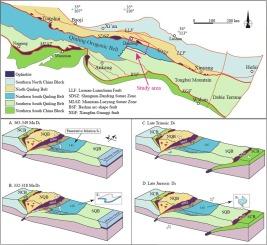Late Paleozoic to Mesozoic tectonic evolution of the Qinling Orogenic Belt: Structural and geochronological constraints from the Devonian Liuling Group, eastern Qinling area, China
IF 2.4
3区 地球科学
Q2 GEOSCIENCES, MULTIDISCIPLINARY
引用次数: 0
Abstract
The Late Paleozoic to Mesozoic tectonic evolution of the Qinling Orogenic Belt is not fully understood. To address this, structural analysis and rutile U-Pb dating were performed on the Middle–Late Devonian Liuling Group located along the northern margin of the South Qinling Belt (SQB). Detailed structural analysis reveals that the Liuling Group experienced four main deformation events (D1–D4). Initial D1 deformation is characterized by intrafolial folds (F1) and a regional penetrative foliation (S1). Subsequent D2 is marked by SW-vergent asymmetric, overturned folds and related crenulation lineation (L2). D3 and D4 are represented by, respectively, nearly E-W trending open folds and NNE-SSW trending centimeter-scale kink folds, both of which slightly modify D1 and D2 structures. Taking into account published chronological data, we propose that D1 and D2 occurred at 363–349 Ma and 332–318 Ma, respectively, and were associated with NE-SW oriented shortening during continental subduction of the SQB. Our new rutile U-Pb ages of 243–240 Ma provide a lower age limit for D3 deformation, which was related to N-S oriented shortening triggered by continental collision between the South China Block (SCB) and SQB along the Mianlue Suture Zone (MLSZ). Finally, D4 deformation was associated with the far-field effects of Late Jurassic subduction of the Paleo-Pacific Plate, which generated a WNW-ESE oriented shortening. Our findings suggest that continental subduction of the SQB continued until the earliest Late Carboniferous. Subsequently, the northern margin of the SQB experienced a Triassic metamorphic overprint triggered by collision between the SCB and SQB.

秦岭造山带晚古生代至中生代构造演化:来自中国秦岭东部泥盆纪柳岭组的构造和地质年代约束
秦岭造山带晚古生代至中生代构造演化尚未完全清楚。为了解决这一问题,我们对位于南秦岭造山带北缘的中-晚泥盆世柳岭组进行了构造分析和金红石U-Pb年代测定。详细的构造分析表明,柳岭组经历了四次主要的变形事件(D1-D4)。最初的D1变形以片内褶皱(F1)和区域性穿透褶皱(S1)为特征。随后的 D2 变形的特征是西南向的不对称、翻转褶皱和相关的褶皱线(L2)。D3 和 D4 分别是近东西走向的开放褶皱和东北-西南走向的厘米级扭结褶皱,两者都对 D1 和 D2 结构略有改动。根据已公布的年代学数据,我们认为D1和D2分别发生于363-349 Ma和332-318 Ma,与SQB大陆俯冲过程中的NE-SW向缩短有关。我们新的金红石U-Pb年龄为243-240 Ma,为D3形变提供了一个年龄下限,D3形变与华南地块(SCB)和SQB沿绵鲁断裂带(MLSZ)的大陆碰撞引发的N-S向缩短有关。最后,D4形变与晚侏罗世古太平洋板块俯冲的远场效应有关,它产生了西北-东南走向的缩短。我们的研究结果表明,SQB的大陆俯冲一直持续到最早的晚石炭纪。随后,SQB 北缘经历了由 SCB 和 SQB 碰撞引发的三叠纪变质叠压。
本文章由计算机程序翻译,如有差异,请以英文原文为准。
求助全文
约1分钟内获得全文
求助全文
来源期刊

Journal of Asian Earth Sciences
地学-地球科学综合
CiteScore
5.90
自引率
10.00%
发文量
324
审稿时长
71 days
期刊介绍:
Journal of Asian Earth Sciences has an open access mirror journal Journal of Asian Earth Sciences: X, sharing the same aims and scope, editorial team, submission system and rigorous peer review.
The Journal of Asian Earth Sciences is an international interdisciplinary journal devoted to all aspects of research related to the solid Earth Sciences of Asia. The Journal publishes high quality, peer-reviewed scientific papers on the regional geology, tectonics, geochemistry and geophysics of Asia. It will be devoted primarily to research papers but short communications relating to new developments of broad interest, reviews and book reviews will also be included. Papers must have international appeal and should present work of more than local significance.
The scope includes deep processes of the Asian continent and its adjacent oceans; seismology and earthquakes; orogeny, magmatism, metamorphism and volcanism; growth, deformation and destruction of the Asian crust; crust-mantle interaction; evolution of life (early life, biostratigraphy, biogeography and mass-extinction); fluids, fluxes and reservoirs of mineral and energy resources; surface processes (weathering, erosion, transport and deposition of sediments) and resulting geomorphology; and the response of the Earth to global climate change as viewed within the Asian continent and surrounding oceans.
 求助内容:
求助内容: 应助结果提醒方式:
应助结果提醒方式:


